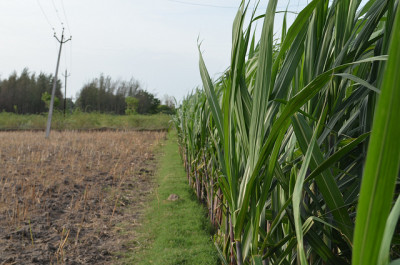by Jyothi Vinod
It takes a while for the train to leave behind the harsh traces of the city and enter the countryside. All of a sudden I’m held in the thrall of a landscape of undulating emerald. For one brief moment I imagine myself running through those sugarcane fields in the manner of a movie heroine. But I remain at my window seat; that daredevilry is best left to denizens of the reel world.
The train hurtles towards its destination much like my own life: unseen carriages ahead lug the old ones behind them. Similar to a carriage in the train, I straddle the past and the future, powerless to change the direction of my journey.
On a train there’s a profitless alternative to reading a book, chatting with co-passengers or pretending to sleep that I’m guilty of indulging in sometimes—the mulling over of mistakes and regrets. Maybe that’s what makes fields and open spaces so alluring to me. They inspire freedom and new beginnings. While unplanned detours for trains have dangerous consequences, I’m luckier. I ride out of the window on a sturdy stalk of sugarcane and stop by an old carriage of my childhood.
Every January, a few sturdy stalks of sugarcane made their way into our home from the market. After the sickle had its say, short clubs of the humbled cane lay together in the kitchen in small pyramids. There was already a container of yellu—a mixture of roasted groundnuts, tiny cuboids of jaggery and dry coconut, and roasted sesame—waiting to be packed into small sachets. Out of bounds, on a high kitchen shelf, was a round steel box that held magic: delicate snow-white figurines of fruits, flowers, birds, animals, gods and pagodas. On the evening of Makar Sankranti I was entrusted with the task of distributing a packet of yellu, a sugar doll, a banana, and a stick of sugarcane to each of our neighbours and friends.
On an afternoon leading to the festival I’d assisted my mother in the creation of those melt-in-the-mouth sugar dolls. It was an elaborate affair. A small kerosene stove with the ‘perfect flame’ was lowered from the attic for this purpose. We sat on the kitchen floor as we worked because the whole process took ages. The wooden moulds were washed and dunked in water. The making of the syrup involved cleaning the sugar solution by repeatedly adding milk, breaking and straining it. My task was to identify the two halves or sometimes three or four parts of a mould, wipe and secure them with rubber bands. I would arrange them on two wooden planks with the opening facing up—ready for the hot syrup. Praying there would be no distractions, my mother stirred small quantities of syrup on the stove. If you prided yourself on pure white dolls—my mother did—you had to remain vigilant. Our usual chatter quickly dropped to monosyllables. When the sugar syrup attained the right consistency, she poured it into the moulds. Like hot candle wax, few drops of the translucent syrup fell on the planks instantly turning opaque—white blobs I coveted.
Despite the harmonious picture our togetherness painted—a master and her apprentice at work—we secretly worked against each other. While she prayed that all the dolls turned out perfect, I hoped that some wouldn’t set properly, or break after they cooled. I was allowed to eat some of the mistakes if I pleaded hard enough. But mistakes to her were useful. They went right back into the pot for another go. After one batch of dolls cooled and were removed, I’d wash the moulds, and set them up again. Over the years as my mother gained expertise, her apprentice faced repeated disappointment. “Have patience,” my mother would rebuke gently. “You can eat them on the day of the festival.”
Despite years of apprenticeship, I’ve made these sugar dolls by myself only twice. Though the outcome was satisfactory, I missed the camaraderie in the kitchen. With a timely courier from my parents delivering a box wherever I was in the country, I never needed to make them again. My parents packed the dolls with care and hoped the big, bold, ‘Handle with Care,’ emblazoned on the package was heeded to by everyone in the courier chain. The dolls would arrive, held snug between tissue paper. Very few suffered damage on transit. The box itself was secured by cellophane tape and covered with two or three layers of thick brown paper. We always telephoned my parents to acknowledge the arrival of the parcel. My daughters would pipe their complaints that they weren’t allowed to eat ‘even the beheaded horse or the broken pergola.’ To which the indulgent grandparents would demand to speak to me. My argument that a waiting time of a couple of days for the festival was in order, met with a, “Oh, these things don’t really matter. Give it to them right away.”
My wily diplomats trod the safe middle path: they ate only the broken ones and offered to wait for the rest. I wondered if my daughters too wished there were damaged ones so that they could get their treats before time. I never found out, and never had to confess my guilty secret.
The making of the sugar dolls is a fine lesson in patience and perseverance. If you weren’t a downright chump who burned the sugar syrup every single time at the very outset, the remaining process of making sugar dolls was kinder to mistakes: a beheaded lion would go back into the pot and emerge as a lotus or a bird; a god who remained gooey even after cooling, was dispatched to the pot to return as a squirrel or a parrot; tailless horses could become pagodas. With maybe thirty or more waiting moulds, mistakes became possibilities.
The sunset flatters the countryside as the train trundles on its journey. I fly back into my carriage—a witch on a sugarcane stalk. The train stops at stations along the way. Nothing prevents me from physically getting off the train and walking into sugarcane fields, but I remain seated for the rest of the journey. I’ve signed up for the destination and that’s where I will get off. But I’ll continue to take sweet detours and add riches to my journey.
We’re lucky it’s that time of the year for new beginnings—a good time to throw our mistakes into the pot and stir it with patience. There’s no telling what magic the moulds will reveal to us.
Pic from https://www.flickr.com/photos/jyotsna210/







Wow! Nice writing. Refreshing, poetic and wonderful to read.
A great article. Thoroughly enjoyed reading it.Takes the reader along right from the train to the fields,onto the child hood,immerses in the mother-daughter affection and reluctantly back to the train journey.
All the very best.
Jyothi,
The article is superb, on how you take ua back to older days, where mothers enjoyed all activities, and how shared their experiences, compared to the quick fix modern days.
Also the end message that mistakes are part of the process is great.
Lovely reading Hope to receive Mouthwatering dolls this year.Happy MakarSankranti to all